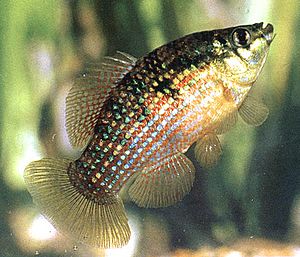Flagfish facts for kids
Quick facts for kids Flagfish |
|
|---|---|
 |
|
| Scientific classification | |
| Synonyms | |
|
Cyprinodon floridae (Goode & T.H. Bean, 1879) |
The flagfish (Jordanella floridae), also known as the American flagfish or Florida flagfish, is a small fish found only in Florida. It is a type of pupfish and belongs to the Cyprinodontidae family. Many people keep flagfish in their aquariums. Its common name comes from the male fish's patterns, which look a bit like the "stars and stripes" of the American flag.
Contents
What Flagfish Look Like
Flagfish are small, strong fish. They grow up to about 6 cm (2.4 inches) long. They have a short, blunt snout, which some people compare to a bulldog's nose. Their fins are rounded. The dorsal (top) and anal fins (bottom rear) are located towards the back of the fish. They are close to the caudal fin (tail fin).
Female flagfish have a clear spot on their sides. They also have a distinct spot near the back of their dorsal fin, which has a white edge. Their fins might sometimes show a slight reddish color, but this color can come and go. The reason for this change is not known. The female's body is mostly olive green with turquoise scales.
The male flagfish gives the species its common name. His patterns look like the flag of the United States. He has a dark rectangle on his shoulder. This is thought to look like the blue area with stars on the US flag. There are also stripes along his sides. Some of these stripes are red, and others are paler, often greenish instead of white. The male also has a dark spot at the bottom back corner of the dark rectangle.
Young flagfish, females, and males that are not dominant usually have an olive-grey color. This less colorful pattern is hidden when a male becomes dominant and shows his bright "flag" pattern.
Where Flagfish Live
The flagfish is found only in Florida. It lives in the Florida Peninsula, south of the St. Johns River and Ochlockonee River areas.
Flagfish Habitat and Life
Flagfish usually live in shallow freshwater areas that have a lot of plants. These places include backwaters, marshes, canals, and ditches. Sometimes, they are also found in slightly salty (brackish) water.
The flagfish is listed in the Guinness World Records! It is known for laying the fewest eggs among fish species. A female flagfish will lay about 20 eggs over a few days.
During courtship, the female will nip the male to encourage him to chase her. Then, they face each other, and the female swims backward. The male then does a backflip. After the eggs are laid, the male often guards them. He will attack other fish that come too close. However, sometimes the male might eat his own eggs or young. Other sources say that this species does not show any parental care at all.
Flagfish are omnivores, meaning they eat both plants and animals. They are "micropredators," which means they hunt very small creatures. They eat small invertebrates (animals without backbones) and zooplankton (tiny animals floating in water). They also eat algae and other plant material.
How Flagfish Got Their Name
The flagfish was officially described by two scientists, George Brown Goode and Tarleton Hoffman Bean, in 1879. They found the first known specimen near Lake Monroe, Florida. The name of the fish's genus, Jordanella, honors an American fish expert named David Starr Jordan (1851-1931). The flagfish is closely related to the Yucatan flagfish (Garmanella pulchra). Sometimes, the Yucatan flagfish is also placed in the Jordanella genus.
See also
 In Spanish: Pez bandera de Florida para niños
In Spanish: Pez bandera de Florida para niños

